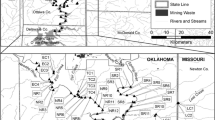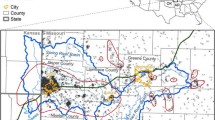Abstract
The Park River watershed (PRW), a sub-basin of the Lower Connecticut River watershed, has experienced increased urbanization over the last century as the city of Hartford and its surrounding towns have grown and developed. We present watershed-wide and outflow scale maps of the trace metals Cd, Cu, Zn, and Pb to determine patterns of contamination in fine (<63 μm) stream sediment. Results are compared to established sediment quality guidelines (SQG) and probable effect concentrations (PEC) for each metal. Throughout the watershed, higher concentrations of trace metals are observed in the more urbanized south branch of the PRW. In this sub-basin, there are more industries that use, and waste, metals in their manufacturing processes that contribute to acutely high concentrations of metals in the fine bedload sediments. Impervious surfaces are examined as well in the context of the entire watershed. While an increase in metals can be attributed to an increase in impervious surfaces, these increases do not generally exceed SQGs and PECs. Two focused mapping studies were conducted at the storm water outflow of the West Hartford Landfill and the Trout Brook Sanitary Sewer Overflow (SSO). The purpose of these studies was to analyze the local effects of natural stream features such as channel bar deposits next to the outfalls. We determined that the sediment directly below the two outfalls often exceeded the PEC, while the accumulated sediment around the channel bar deposits was not contaminated beyond background stream levels. We believe mapping at both the small (watershed) and large (outfall) scale can be helpful in future urban studies to determine the extent of trace metal sediment contamination in both channelized and natural sections and may provide a useful method for sediment mitigation endeavors.








Similar content being viewed by others
References
Breault, R. F., & Harris, S. L. (1997). Geographical distribution and potential for adverse biological effects of selected trace elements and organic compounds in streambed sediment in the Connecticut, Housatonic, and Thames River Basins, 1992–1994. U.S. Geological Survey Water-Resources Investigations Report 97-4169.
Burton, A. (2002). Sediment quality criteria in use around the world. Limnology, 3, 65–75.
Exum, et al. (2010) Assessing and reporting water quality: questions and answers. Environmental Protection Agency: Ecosystems Research Division. http://www.epa.gov/waters/ir/attains_q_and_a.html#7.
Giddings, E. M., Hornberger, M.I., & Hadley, H.K. (2001). Trace-metal concentrations in sediment and water and health of aquatic macroinvertebrate communities of streams near park City, Summit County, Utah. USGS. Water-Resources Investigations Report 01-4213.
Hill, M. (2010). Abnormal development: heavy metals. University of New South Wales. Received October 20, 2011. http://php.med.unsw.edu.au/embryology/index.php?title=Abnormal_Development_-_Heavy_Metals.
Ingersoll, C., MacDonald, D., Wang, N., Crane, J., Field, L., Haverland, P., et al. (2000). Prediction of sediment toxicity using consensus-based freshwater sediment quality guidelines. Prepared by U.S. Geological Survey for U.S. Environmental Protection Agency Great Lakes National Program Office (GLNPO). Chicago. EPA 905/R-00/007. http://www.cerc.usgs.gov/pubs/center/pdfDocs/91126.pdf.
Ingersoll, C. G., MacDonald, D. D., Wang, N., Crane, J. L., Field, L. J., Haverland, P. S., et al. (2001). Predictions of sediment toxicity using consensus-based freshwater sediment quality guidelines. Archives of Environmental and Contamination Toxicology Journal, 41(1), 8–21.
Jenne, E. (1976). Trace Element sorption by sediments and soils — sites and processes. In Chappell, W., & Peterson, K. (eds.), Symposium on molybdenum. Vol. 2. (425–553).
Klerks, P. L., & Weis, J. (1986). Genetic adaptation to heavy metals in aquatic organisms: a review. Environmental Pollution, 45(3), 173–205.
Lyman, W. J., Glazer, A. E., Ong, J. H., & Coons, S. F. (1987). An overview of sediment quality in the United States. Washington D.C: US Environmental Protection Agency.
MacDonald, D. D., Ingersoll, C. G., & Berger, T. A. (2000). Development and evaluation of consensus based sediment quality guidelines for freshwater ecosystems. Archives of Environmental and Contamination Toxicology Journal, 39, 20–31.
Metropolitan District Commission (MDC). (2012). Clean Water Project. Retrieved on March 15, 2012. http://themdc.com/abouttheproject.shtml.
Miller, J. R., & Miller, S. M. (2007). Contaminated rivers. Dordrecht: Springer.
Rice, K. (1999). Trace elements concentrations in stream bed sediment across the United States. Environmental Science Technology, 33, 2499–2504.
Right-To-Know-Network. (2010). TRI Facilities for West Hartford, CT. Retrieved October 20, 2011, from Right-To-Know Network. http://www.rtknet.org/db/tri/tri.php?database=tri&reptype=f&reporting_year=2009&corechem=n&rsei=y&detail=-1&dbtype=C&sortp=D&datype=T&state=CT.
Sansalone, J., & Buchberger, S. (1997). Partitioning and first flush of metals in urban roadway storm water. Journal of Environmental Engineering, 123(2), 134–143.
Schueler, T. (1994). The importance of imperviousness. Watershed Protection Techniques, 2(4), 100–111.
US Environmental Protection Agency. (2004). The incidence and severity of sediment contamination in surface waters of the United States. EPA 823-R-04-007. Science and Technology Office, Washington, DC.
Acknowledgments
We thank the Trinity College Environmental Science Program for providing funding for this research. In addition, we thank the Trinity College 2011 Methods class and faculty and students from the University of Connecticut and Connecticut Central University for contributing to the watershed-wide sampling effort. We thank Emily Wilson from CLEAR who provided us with updated impervious cover maps for the Park River watershed. We also appreciate the careful work of our reviewers who helped improve many details of this paper.
Author information
Authors and Affiliations
Corresponding author
Rights and permissions
About this article
Cite this article
Semrod, K.A., Gourley, J.R. Mapping the Distribution of the Bioaccessible Fraction of Trace Metals in the Sediments of an Urban Stream, Park River Watershed, Connecticut. Water Air Soil Pollut 225, 2029 (2014). https://doi.org/10.1007/s11270-014-2029-3
Received:
Accepted:
Published:
DOI: https://doi.org/10.1007/s11270-014-2029-3




